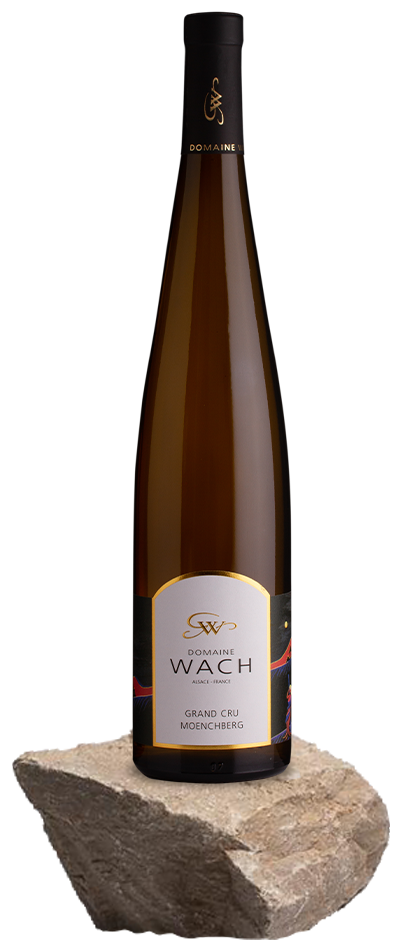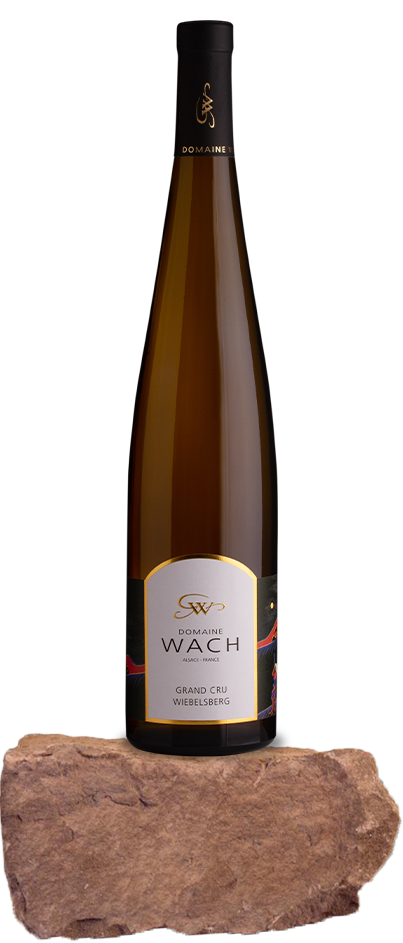Our Vintage Wines
Un savoir-faire authentique
Du cep de vigne à la table s’enchaînent un lot de tâches, de défis et de surprises. Valoriser sa terre, c’est capturer avec ardeur la mémoire du terroir viticole, du cépage, et du millésime. Un savoir-faire authentique raisonne chez Pierre Wach, 7e génération de vignerons.
Ce savoir-faire prend racine depuis 1648, moment où la famille Wach fait ses débuts dans le monde du vin en exerçant le métier d'artisan tonnelier. À partir de 1780, la production de vin diversifie les activités commerciales. Depuis 1888, le métier de vigneron Alsacien résonne à plein temps.
An authentic know-how:
From the vine to the table, a lot of tasks, challenges and surprises follow. Enhancing the value of his land means ardently capturing the memory of the wine-growing terroir, the grape variety, and the vintage. Pierre Wach, the 7th generation of winegrowers, is steeped in authentic know-how.
This know-how has its roots in 1648, when the Wach family began working in the world of wine as a cooper. From 1780 onwards, wine production diversified the business. Since 1888, the profession of Alsatian winegrower has been in full swing.
The Vintage wines
In Alsace, this old notion refers to the most prestigious wines of the region. Precious wines. Wines of time. Wines that shine with fine cuisine.
Qu’est-ce qu’un Grand Cru d’Alsace ?
La notion de vins d’Alsace grands crus est très ancienne. De Marlenheim à Thann, les villages viticoles bénéficient d’un ou plusieurs grands crus respectifs. Le grand cru Steinert sera donc issu de vignes situées à Pfaffenheim, tandis que Kessler fera référence à Guebwiller. Dans tous les cas, les raisins proviennent d’une délimitation parcellaire précise présentant terroir exceptionnel.
Le terroir, c’est l’ensemble de critères géologiques et climatiques qui influencent le raisin. À cela s’ajoutent les facteurs humains, telles que les décisions de culture, qui jouent aussi sur la qualité finale. Et puisque le vin se fait d’abord à la vigne, ces parcelles dites exceptionnelles devraient donc signer les plus prestigieux vins de la région. À des lieux de production strictement définis s’ajoute aussi un rigoureux cahier des charges propre à chaque vins d’Alsace grand cru.
Des vins d’exception :
Aujourd’hui, 51 vins d’Alsace grands crus parsèment l’axe nord-sud de la région. Ces derniers sont issus de l’un des 4 cépages nobles de la région, soit le Riesling, le Pinot Gris, le Gewurztraminer, ou le Muscat. Concernant l’encépagement, quelques exceptions, que nous tairons ici, existent. Ces grands vins se veulent authentiques, taillés pour la table, et pour un vieillissement prolongé.
Malgré la renommée de certaines bouteilles, les vins d’Alsace grands crus ne représentent qu’environ 5% de la production régionale.
Au Domaine Wach, un élevage prolongé en bouteille permet à nos vins d’Alsace grands crus de révéler une énergie rayonnante, et une profonde élégance. Dans le confort de votre cave, un exercice de temps récompensera les plus patients ; les vins développeront un caractère minéral et une texture intrinsèques à leur terroir (marno-calcaire, grès rose, ou schiste).
What is a Grand Cru d'Alsace?
The notion of Alsace Grand Cru wines goes back a long way. From Marlenheim to Thann, the wine-producing villages have one or more respective Grand Crus. The Steinert grand cru will thus come from vines located in Pfaffenheim, while Kessler will refer to Guebwiller. In all cases, the grapes come from a precise parcel delimitation with exceptional terroir.
Terroir is the set of geological and climatic criteria that influence grapes. Added to this are human factors, such as cultivation decisions, which also play a part in the final quality. And since wine is first and foremost made in the vineyard, these so-called exceptional parcels are destined to product the region's most prestigious wines. In addition to strictly defined production sites, each Alsace Grand Cru wine is subject to rigorous specifications.
Exceptional wines:
Today, 51 Alsace Grand Cru wines highlight the north-south axis of the region. These wines are made from one of the 4 noble grape varieties of the region, namely Riesling, Pinot Gris, Gewurztraminer or Muscat. Concerning the grape varieties, some exceptions exist, which we will not mention here. These great wines are authentic, made for the table, and for prolonged aging.
In spite of the fame of certain bottles, Alsace Grand Cru wines only represent about 5% of the regional production.
At Domaine Wach, a prolonged ageing in bottle allows our Alsace Grand Cru wines to reveal a radiant energy and a deep elegance. In the comfort of your cellar, waiting time will reward the most patient; the wines will develop a mineral character and a texture intrinsic to their terroir (marl, pink sandstone, or schist).
Discover the Grands Crus of the domain:
At Domaine Wach, we are pleased to represent the 3 Alsace Grand Cru wines linked to the village of Andlau:
Moenchberg, Wiebelsberg, and Kastelberg.
The passion we have for the Riesling grape variety echoed in each of these vintages.

Moenchberg
Riesling
Exotic fruit, voluminous & bright.
-
Details
Moenchberg, which means monks’ mountain, is one of the oldest vineyards in Alsace planted with vines. Indeed, the Benedictine monks of the Altorf abbey already owned it in the early 1900s. Located on a marl-limestone soil, this Alsace Grand Cru wine reveals aromas of exotic fruit and warm limestone.
On the palate, the wine is very structured, and fills the palate with brilliance.
With food, it is a perfect match for a scallop shellfish or a dessert based on yellow fruits.

Wiebelsberg
Riesling
Lemony, chiselled & fine saltiness.
-
Details
Wiebelsberg, which means ladies’s mountain, comes from an extremely pure pink sandstone terroir, expressing a saline and pure sensation. This Riesling is particularly racy and elegant.
On the nose, lemon dominates. The mouth is very mineral and a delicate acidity develops in the finish. In its youth, this great white will be particularly fresh and fruity. The wisest will wait a few years; it will improve by developing an intense mineral character.
The iodized flavors of seafood will then accompany it with dignity.

Kastelberg
Riesling
Dry, mineral, robust & salty.
-
Details
Kastelberg, which means the terraced mountain, is one of Alsace's rarest Grand Cru wines, thanks to its unique schist terroir. With its 5.82 hectares, it is the second smallest grand cru in Alsace. On the nose, lime dominates. Nice aromas of gunflint too.
On the palate, the mineral tension tickles the sides of the tongue, makes you salivate, and invites you to taste again. The length in the mouth is simply magnificent. It will be wise to wait a few years before opening a bottle of Riesling Grand Cru Kastelberg. It will then reveal all the breed of its terroir.
When the time comes, joyfully prepare a delicate fish or poultry.






